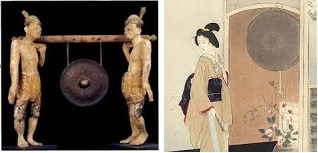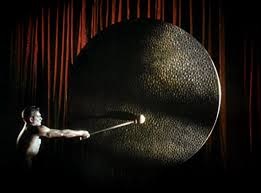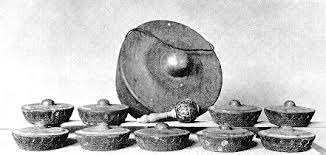
Music is the much needed succour to enhance spiritual, emotional and physical well being and musical instruments provide the means to achieve this state. The Gong, with its deep resonating sound is one such musical instrument. Made from metal, it is disc–shaped and sounds loud when hit by a mallet or stick. When the Gong is sounded, each and every cell of the body feels the vibrations. A complex range of frequencies is created by its multi–layered sound which is deeply relaxing and rejuvenating. The sound and the name of the Gong represent each other. Along with the bell, the Gong has been an important influencing factor on human life. Meditation, healing, communication, ceremonies and announcements are some of the ancient uses of the Gong in the Buddhist culture. In Asian cultures, Gong is considered as an important part of ceremonies. Belonging to the percussion family of musical instruments, the sound of the Gong is loud enough to be heard miles away.
The Gong is considered to be the earliest known musical instrument dating back to the Bronze Age. The countries of origin of the Gong are believed to be China, Annam, Burma, Java and other Asian countries. Gongs have been in use since the times of Gautam Buddha, which is as early as 600 BC. It was deployed for other purposes such as healing and communication and announcements and was mostly used by kings and monarchs. Gongs have been used in Europe in orchestras in the late 17th century. It was an important instrument for the people of Asia and continues to be an important part of culture and traditions.

The sound of a Gong is sonorous and deep. Variations in sound are produced when the Gong is hit by the mallet in different places. In an orchestra, the Gong is used to create an atmosphere of fear and horror with the continuous and intense striking. The Chinese tam-tam is effectively used to create such an effect in dramatic sequences. Techniques such as scraping, tapping, rubbing and unconventional beating of the Gong are employed to create an ‘eerie’ effect. Gong vibrates most at the centre but it does not struck in the middle, but slightly at a distance. Great volume and low notes are produced at a point which is far away from the centre. The perfect sounding point differs for different types of instruments and the right sound is achieved by trial and error.

More than the music, the Gong is considered to be a therapeutic instrument used in sound meditation and vibration therapy. The sound of the Gong creates a reverberating effect on the mind and transports it from conscious to the sub–conscious mind and back. This helps in reducing stress levels. The earlier Gongs were struck to indicate royalty and seniority. Apart from this, Gongs and their latest versions are used as an effective means of communication and signal such as in railways, boxing rings, orchestras, sirens and theatres. Tam–tam, a type of Chinese Gong is widely used in the drum kit ensemble of a symphony orchestra.
Gong is a flat, circular disc–shaped musical instrument made from metal. Bronze (an alloy of copper and tin), brass and other alloys are used to make Gongs. The alloy is heated and poured into moulds or castings. The castings are hammered into a shape when hot and then cooled slowly and is again re–heated and cooled slowly, which hardens them. A percussion instrument, Gong is sounded when struck by a mallet or a drum stick in the centre. The mallet or stick is short, hard and is fitted with a leather–covered round pad on one end. Bigger the size of the Gong, shorter is the mallet or hammer is used.

Gongs are classified into Suspended, Bossed or Nipple and a third variant being Bowl–shaped.
- Traditional Suspended Gongs are flat, disc–shaped and suspended vertically from a stand, with or without a turned edge and with a raised centre. They are also known as chau, bulls eye and tam–tam.
- Bossed or Nipple Gongs have a raised centre, are suspended but in a horizontal position and are also known as Pot Gongs and used in melodic elements.
- Bowl Gongs are normally used in temple worship and may be struck with a beater or rubbed at the rim with the fingers. They are more like the bells.
Other varieties of Gong include the Opera gong, Pasi Gong, Wind Gong, Tiger Gong, Modern Orchestral Gongs, Planet Gongs and Sound Creation Gongs.

G Kowledge of | 0 Comments >>
0 Comments
Leave Comment
Your email address will not be published. Required fields are marked.